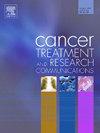Advancements in nasopharyngeal carcinoma radiotherapy: Dosimetric evaluation of arc therapy with hippocampal sparing
IF 2.4
Q3 Medicine
引用次数: 0
Abstract
Background
Nasopharyngeal carcinoma (NPC) is located near critical structures like the hippocampus, essential for memory and cognitive function. While Volumetric Modulated Arc Therapy (VMAT) has improved dose conformity in NPC treatment, the integration of hippocampal-sparing (HS) approaches remains underexplored. This study evaluates the dosimetric feasibility and effectiveness of hippocampal-sparing VMAT (HS-VMAT) in NPC, focusing on reducing radiation exposure to the hippocampus while maintaining target volume coverage.
Methods
We conducted a retrospective cohort study of 20 NPC patients treated at Cheikh Khalifa International University Hospital between 2020 and 2023. Each patient underwent two radiotherapy plans: one with hippocampal sparing and one without. Dosimetric parameters for planning target volumes (PTVs) and organs at risk (OARs) were analyzed. Independent samples t-tests were used for statistical analysis with a significance level of p < 0.05.
Results
For the high-risk PTV (PTV HR), there were no significant differences in maximum dose (D2 %) between HS and non-HS groups (71.71 ± 0.23 Gy vs. 71.65 ± 0.11 Gy; p = 0.298). The minimum doses (D95 %, D98 %) and mean dose (Dmean) were slightly lower in the HS group, though not statistically significant. For intermediate- and low-risk PTVs, dose metrics remained similar across groups. Hippocampal sparing significantly reduced doses to the hippocampus. The minimum dose (Dmin) decreased from 5.87 ± 2.06 Gy to 3.93 ± 0.45 Gy (p = 0.001), and the maximum dose (Dmax) decreased from 10.73 ± 3.62 Gy to 7.40 ± 1.25 Gy (p = 0.001). Radiation doses to critical structures were also reduced. The brainstem Dmax decreased from 35.68 ± 5.31 Gy to 30.12 ± 4.71 Gy (p = 0.001), and the left parotid gland Dmoy decreased from 21.38 ± 5.38 Gy to 18.32 ± 2.53 Gy (p = 0.029).
Conclusion
HS-VMAT for NPC effectively reduces hippocampal and critical structure radiation doses without compromising target volume coverage. This technique offers a feasible approach to minimize neurocognitive risks while maintaining treatment efficacy.
鼻咽癌放射治疗的进展:海马保留弧治疗的剂量学评价
鼻咽癌(NPC)位于海马等关键结构附近,对记忆和认知功能至关重要。虽然体积调制弧线疗法(VMAT)改善了鼻咽癌治疗的剂量一致性,但保留海马(HS)方法的整合仍未得到充分探索。本研究评估了鼻咽癌海马保留VMAT (HS-VMAT)的剂量学可行性和有效性,重点是在保持靶体积覆盖的同时减少海马的辐射暴露。方法对2020年至2023年在谢赫哈利法国际大学医院治疗的20例鼻咽癌患者进行回顾性队列研究。每位患者接受了两种放疗计划:一种是保留海马,另一种没有。分析了规划靶体积(pvs)和危险器官(OARs)的剂量学参数。采用独立样本t检验进行统计学分析,显著性水平为p <; 0.05。结果高危PTV (PTV HR), HS组与非HS组最大剂量(D2 %)差异无统计学意义(71.71±0.23 Gy vs 71.65±0.11 Gy, p = 0.298)。HS组最小剂量(d95%, d98%)和平均剂量(Dmean)略低于对照组,但无统计学意义。对于中危和低危ptv,剂量指标在各组之间保持相似。海马保留显著减少了海马的剂量。最小剂量(Dmin)由5.87±2.06 Gy降至3.93±0.45 Gy (p = 0.001),最大剂量(Dmax)由10.73±3.62 Gy降至7.40±1.25 Gy (p = 0.001)。对关键建筑物的辐射剂量也减少了。脑干Dmax由35.68±5.31 Gy降至30.12±4.71 Gy (p = 0.001),左腮腺Dmoy由21.38±5.38 Gy降至18.32±2.53 Gy (p = 0.029)。结论hs - vmat治疗鼻咽癌可有效降低海马和关键结构辐射剂量,且不影响靶体积覆盖。这项技术提供了一种可行的方法,以尽量减少神经认知风险,同时保持治疗效果。
本文章由计算机程序翻译,如有差异,请以英文原文为准。
求助全文
约1分钟内获得全文
求助全文
来源期刊

Cancer treatment and research communications
Medicine-Oncology
CiteScore
4.30
自引率
0.00%
发文量
148
审稿时长
56 days
期刊介绍:
Cancer Treatment and Research Communications is an international peer-reviewed publication dedicated to providing comprehensive basic, translational, and clinical oncology research. The journal is devoted to articles on detection, diagnosis, prevention, policy, and treatment of cancer and provides a global forum for the nurturing and development of future generations of oncology scientists. Cancer Treatment and Research Communications publishes comprehensive reviews and original studies describing various aspects of basic through clinical research of all tumor types. The journal also accepts clinical studies in oncology, with an emphasis on prospective early phase clinical trials. Specific areas of interest include basic, translational, and clinical research and mechanistic approaches; cancer biology; molecular carcinogenesis; genetics and genomics; stem cell and developmental biology; immunology; molecular and cellular oncology; systems biology; drug sensitivity and resistance; gene and antisense therapy; pathology, markers, and prognostic indicators; chemoprevention strategies; multimodality therapy; cancer policy; and integration of various approaches. Our mission is to be the premier source of relevant information through promoting excellence in research and facilitating the timely translation of that science to health care and clinical practice.
 求助内容:
求助内容: 应助结果提醒方式:
应助结果提醒方式:


